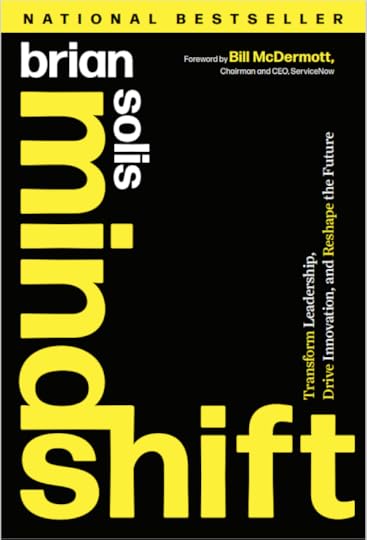Brian Solis's Blog, page 8
March 10, 2025
Mindshift or Die! How to Stay Ahead in the Age of AI and Disruption
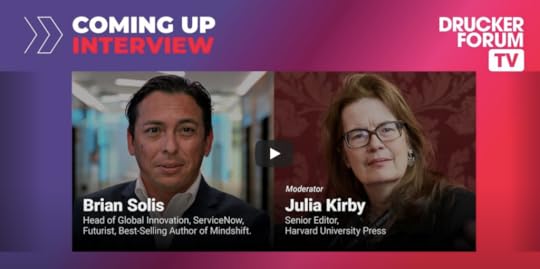
In today’s fast-moving world, change isn’t just happening—it’s accelerating. The pace of disruption is outpacing the ability of many leaders and organizations to keep up. That’s why I believe we need a Mindshift—a fundamental transformation in how we think, lead, and innovate.
Recently, I had the opportunity to sit down with Julia Kirby, Senior Editor, Harvard University Press, for an insightful conversation about digital transformation, AI, and leadership. We explored the key challenges businesses face today and, more importantly, how leaders can embrace this new era with confidence. Here are some key takeaways from our discussion. The conversation followed an amazing on stage exploration of the augmented and exponential power of an AI-first mindset. I’d always dreamed of speaking at Drucker Forum!
The Age of Digital DarwinismFor over 20 years, I’ve talked about Digital Darwinism—the idea that technology and society are evolving faster than most organizations can adapt. This isn’t just about technology; it’s about how customer expectations, behaviors, and preferences are changing. The businesses that fail to adapt risk becoming obsolete, while those that embrace transformation can unlock entirely new opportunities.
“We’re in a time when the old way of doing things just doesn’t work anymore. Leaders can’t simply tweak existing processes; they need to rethink everything—from business models to customer engagement,” I explained in the interview.
The organizations that succeed are those that challenge conventions and have the courage to rethink their strategies. And that starts with leadership.
AI: A Catalyst for Human PotentialOne of the biggest topics we explored was the role of AI in business. There’s a lot of fear around AI replacing jobs, but I see it differently. AI isn’t here to replace humans—it’s here to augment human capabilities.
“Leaders who see AI as a tool to amplify creativity, efficiency, and decision-making will be the ones who create the most value,” I shared. The key is reskilling and upskilling employees so they can work alongside AI rather than be displaced by it.
AI is not the future—it’s the present. Organizations that fail to embrace it will find themselves left behind. The real question is: How can we use AI to make work more meaningful, more productive, and more human?
The Urgency of a MindshiftLeading in this era requires more than just digital transformation—it requires a leadership transformation. Traditional leadership models were built for a different time, a different pace. Today, leaders must cultivate curiosity, adaptability, and resilience to thrive.
“The most successful leaders I know aren’t just reacting to change—they’re anticipating it, shaping it, and even creating it,” I emphasized in our conversation. This means shifting from a fixed mindset to a growth mindset, from control to empowerment, and from certainty to experimentation.
The Future Belongs to Those Who Challenge the Status QuoThis is a defining moment. Organizations have a choice: cling to outdated models and risk irrelevance, or embrace transformation and become the architects of the future.
“Businesses need to stop waiting for disruption to happen to them and instead become the disruptors,” I said in the interview.
This means investing in innovation, fostering a culture of learning, and prioritizing customer experience and employee experience in every decision.
Final ThoughtsMindshift isn’t just a book title—it’s a call to action. Leaders must unlearn old ways of thinking and embrace new possibilities. The organizations that succeed will be the ones that prioritize continuous learning, rethink traditional hierarchies, and use technology as a force for good.
The future isn’t something that just happens to us—it’s something we create. And it starts with a Mindshift.
—
What’s your biggest challenge when it comes to digital transformation?
Let’s continue the conversation—drop a comment or connect with me on LinkedIn, Threads, BlueSky and X.
Order Mindshift, today!
The post Mindshift or Die! How to Stay Ahead in the Age of AI and Disruption appeared first on Brian Solis.
March 9, 2025
The Futurists: 2025 Outlook With Brett King, Robert Tercek, and Brian Solis

“The Futurists,” Brett King, Rob Tercek, and yours truly, get together to brainstorm and model the possible big advances and macro changes that are likely to come in 2025. From Trump’s first year back, to the broader market changes and climate impact issues. This is what happens when you let three futurists out after dark to talk about short-term futures
Watch 
The post The Futurists: 2025 Outlook With Brett King, Robert Tercek, and Brian Solis appeared first on Brian Solis.
March 3, 2025
Authority Magazine Posts In-Depth Interview with Brian Solis Author of Mindshift
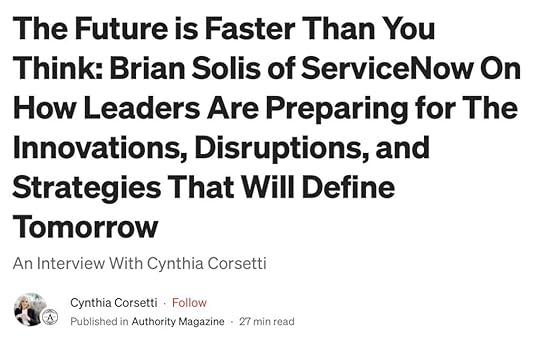
This is an excerpt from Authority Magazine, one of the most in-depth interviews Brian Solis has ever conducted.
In the interview, Cynthia Corsetti and Brian explored how leaders must rethink their approach to innovation, disruption, and transformation in an era where AI, automation, and customer expectations are evolving at breakneck speed. They also crack the cover to Brian’s new book Mindshift: Transform Leadership, Drive Innovation, and Reshape the Future.
Here are some key takeaways:
 AI isn’t just a tool—it’s a collaborator.
AI isn’t just a tool—it’s a collaborator. Incremental change is no longer enough.
Incremental change is no longer enough. Experience is the next competitive edge.
Experience is the next competitive edge. The biggest risk? Standing still.
The biggest risk? Standing still.
Adopt a Beginner’s Mindset: The first step in preparing for disruption is letting go of what you think you know. A beginner’s mindset allows you to approach challenges with curiosity, humility, and openness to new possibilities. Leaders must constantly unlearn outdated paradigms and embrace new ways of thinking. As I write in Mindshift, the most dangerous phrase in times of disruption is, “This is how we’ve always done it.”
The pace of change is accelerating, with innovations and disruptions reshaping industries faster than ever. Leaders must not only anticipate these changes but also develop strategies to thrive in this evolving landscape. How are forward-thinking leaders preparing for the technologies and challenges of tomorrow? What strategies are they putting in place today to ensure success in the future? As part of this series, we are interviewing Brian Solis.
Brian Solis serves as the Head of Global Innovation at ServiceNow where he drives vision, strategy, and insights for the company’s Office of Innovation with Dave Wright, Chief Innovation Officer. Brian partners with customer executives and ServiceNow leaders to advise on disruptive trends and next-generation innovation and business transformation strategies.
Brian is a world-renowned futurist, 9x best-selling author, and international keynote speaker. He is the author of over 60 widely read research reports that explore the future of business and industries, disruptive technologies, and important consumer shifts. He has consistently been recognized as one of the world’s leading thinkers in innovation, business transformation, and leadership for over two decades. Brian continues to publish business and technology thought leadership in industry publications such as HBR, Fast Company, CIO, Forbes, and Worth.
Thank you so much for joining us in this interview series. Before we dive into our discussion, our readers would love to “get to know you” a bit better. Can you share with us the backstory about what brought you to your specific career path?
Please read the full interview at Authority Magazine.
The post Authority Magazine Posts In-Depth Interview with Brian Solis Author of Mindshift appeared first on Brian Solis.
February 27, 2025
RGP – Why Now Is a Mindshift Moment: A Conversation with Futurist Brian Solis
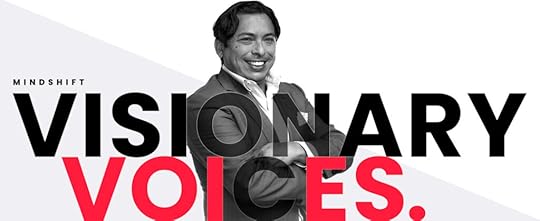
Brian Solis is a world-renowned digital anthropologist and futurist who serves as the Head of Global Innovation at ServiceNow. In his role, Brian advises business and technology leaders around the world on business and digital innovation and transformation strategies. He is also an award-winning author and global keynote speaker.
Brian sat down with RGP for an interview following the publication of his new book: Mindshift: Transform Leadership, Drive Innovation, and Reshape the Future.
Embracing a Mindset of Curiosity & OpportunityWhile technology is advancing exponentially, our mindsets, approaches, and leadership frameworks are struggling to keep pace. To thrive now, leaders must ignite a new form of awareness and creativity, one that transcends traditional business principles and embraces deeper exploration of the unknown and a deeper understanding of humanity and its evolving needs.
A mindshift is a profound change in how we perceive the world, approach challenges, and embrace opportunities. It’s not just about adopting new ideas—it’s about rewiring our perspectives, unlearning outdated beliefs, and looking into the future and embracing the art of wonder and the art of the possible.
A mindshift is the key to moving from survival mode to thriving in a future defined by the unknown, uncertainty, and disruption.
The moment a mindshift happens, it is often sparked by a combination of awareness and newfound curiosity and intention. It occurs when individuals or leaders realize that the status quo is no longer sufficient, that clinging to old mindsets or strategies is limiting, holding back progress, and that they must evolve to stay relevant.
This can be triggered by a disruptive event, such as a technological breakthrough, a market shift, a global event, or a personal epiphany. In these moments, a choice emerges: resist change and remain reactive or embrace a new way of thinking to proactively shape the future.
The mindshift moment is like a “Ctrl + Alt + Delete” opportunity—a chance to reboot one’s mindset and take intentional steps toward reinvention … an intellectual and creative upgrade. It’s a decision to break free from legacy thinking, embrace curiosity, and open the door to new possibilities. Ultimately, a mindshift is what enables leaders to navigate ambiguity, inspire teams, and drive innovation in a rapidly changing world.
A mindshift is about adopting a mindset that doesn’t just react to disruption but actually anticipates it, harnesses it, and sees around corners.
How Seismic Shifts Will Redefine Industries & Human ExperiencesWhat is your vision of the “waves of new capabilities, products, ecosystems, and behaviors” that you predicted will be coming in the next five years?
The waves of shifts that span across tech, capabilities, markets, and behaviors are where companies do need to spend time and attention as an everyday practice.
Now’s the time.
The next five years will continue to bring seismic shifts in technology, creating opportunities that stretch beyond our imagination. Ongoing AI evolution, spatial and ambient computing, quantum technology, and blockchain will converge to redefine industries and human experiences.
For CEOs and technology and business leaders, the challenge is to embrace an open mindset of curiosity and possibility. Instead of fearing disruption or responding to disruption with the business-as-usual playbook, they must see themselves as architects of a future that is not yet written. If not them, then who?
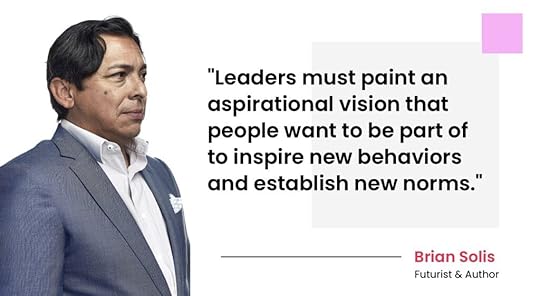
Imagine a CEO in retail leveraging AI to craft hyper-personalized online and physical customer journeys that anticipate needs before customers even articulate them. Picture spatial and ambient computing transforming hospitality into immersive experiences where travelers interact with AI-guided digital concierges in augmented environments or have their spaces personalized to them as they arrive.
In healthcare, AI-driven diagnostics could enable entirely new business models, like subscription-based proactive wellness platforms that continuously monitor and adapt to patient needs.
To shift the narrative of AI from fear to wonder is a competitive advantage. Leaders need to ask: “How might this technology extend human potential?” For example, AI isn’t here to replace; it’s here to augment—taking care of repetitive tasks so humans can focus on creativity, strategy, and connection. Imagine what can be done with saved time and resources?
Rather than simply benefit from the scale and efficiencies of automation, explore how to augment human capital in ways that unlock untapped value creation.
This reframe can ignite a culture of awe within organizations, turning skeptics, pessimists, and those with fixed mindsets into advocates and opportunists. Leaders who’ve made this shift tell me it’s like opening a window to a world of endless possibility. They no longer see AI or the unknown as disruptors but as partners for crafting an extraordinary future. And that’s really what this is about: Investing in tracking, understanding, and exploiting trends before they force you to react in the present.
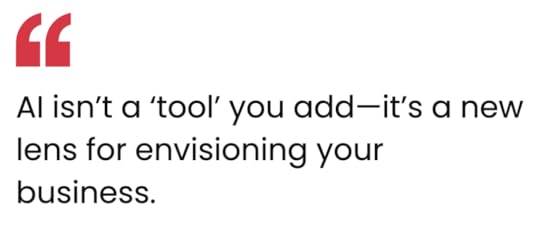
What are some of the catalysts in AI transformation that will supercharge revenue growth and innovation on a continual basis?
AI is rewriting the rules of business growth by combining automation with augmentation. But organizations are largely experimenting with automation. And that’s normal.
Generative AI, for example, represents a catalyst not only for efficiency but for augmentation and innovation. This is where a mindshift comes in. It asks different questions with the intent to discover new answers and the commitment to explore the unknown.
Consider the logistics industry: AI-powered supply chain tools predict disruptions and reroute shipments before bottlenecks occur, enabling just-in-time manufacturing on a global scale. Or think about marketing—where generative AI analyzes customer behavior in real-time to create campaigns that resonate on a deeply personal level.
Consider the burnout facing caregiving in the healthcare system. AI could be present in patient discovery and diagnosis. Or, it could be part of every engagement along the patient journey to synthesize interactions and collaborate with caregivers toward potentially more accurate next steps. It could then connect those summaries and next steps into systems to free up time from the manual processes required at each step today.
Tesla’s AI strategy exemplifies this. The company doesn’t just use AI to power its autonomous vehicles—it employs it to optimize manufacturing processes, from robotics to predictive maintenance. This creates a virtuous cycle of efficiency and innovation.
For CEOs, the lesson is to focus on areas where AI can transform the ordinary into the extraordinary. By automating routine tasks, organizations free up bandwidth to solve complex, high-value problems.
Pairing automation with augmentation also empowers employees. Tools like AI-assisted design platforms allow engineers and creatives to focus on ideation rather than execution.
Leaders should ask themselves: “Where can we use AI to elevate human ingenuity or even my own vision leadership?” The answer often lies in combining the analytical power of AI with the empathetic, creative, and strategic strengths of humans.
Leaders Must Paint an Aspirational Vision for the FutureYour book talks about the importance of storytelling. Why is this so key in this time of transformation?
Storytelling is the most powerful tool leaders have to humanize change management and transformation. In an age of rapid disruption, a compelling narrative helps people understand why change is necessary and how they can play a role in shaping it.
Effective stories have three elements:
1. A relatable protagonist (the company, the customer, or even the employee)
2. A conflict (the challenge of disruption)
3. And a resolution (the inspiring vision of the future)
Leaders must master the art of painting vivid pictures of the future—a future motivating state, backed by concrete actions that bring those visions to life. More importantly, leaders must paint an aspirational vision that people want to be part of, to inspire new behaviors, and establish new norms.
A great story turns transformation into a shared journey, inspiring employees and stakeholders to join in.
The post RGP – Why Now Is a Mindshift Moment: A Conversation with Futurist Brian Solis appeared first on Brian Solis.
February 26, 2025
ServiceNow’s Head of Global Innovation Brian Solis to Open AI Week in Milan, Italy
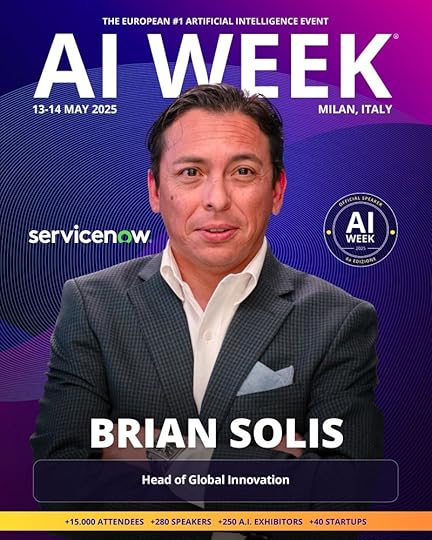
ServiceNow will take center stage at AI WEEK 2025 with Brian Solis, Head of Global Innovation, one of the leading experts in digital transformation and innovation strategies.
During his talk, Brian will explore the evolution of Artificial Intelligence in the business landscape, the growing role of AI agents, and the need for a new leadership mindset to drive AI-powered enterprises. A valuable contribution made possible thanks to the collaboration with ServiceNow.
 May 13-14, 2025 | Milano Fiera Rho
May 13-14, 2025 | Milano Fiera Rho Tickets and info at www.aiweek.it
Tickets and info at www.aiweek.it

 ANNUNCIO SPEAKER
ANNUNCIO SPEAKER 
ServiceNow sarà protagonista sul Main Stage della AI WEEK 2025 con Brian Solis, Head of Global Innovation, tra i massimi esperti di trasformazione digitale e strategie di innovazione.
Durante il suo intervento, Brian approfondirà l’evoluzione dell’Intelligenza Artificiale nel contesto aziendale, il ruolo crescente degli agenti AI e l’importanza di un nuovo approccio alla leadership per le imprese orientate all’innovazione. Un contributo di valore reso possibile grazie alla collaborazione con ServiceNow.
 13-14 maggio 2025 | Milano Fiera Rho
13-14 maggio 2025 | Milano Fiera Rho Biglietti e informazioni su www.aiweek.it
Biglietti e informazioni su www.aiweek.it
The post ServiceNow’s Head of Global Innovation Brian Solis to Open AI Week in Milan, Italy appeared first on Brian Solis.
February 21, 2025
Lifescale by Brian Solis Listed in the 10 Best Modern Marketing Books for Leaders & CMOs by Senior Executive
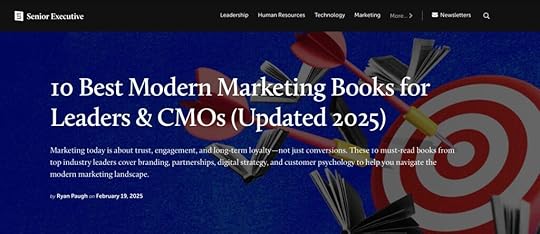
Writing for Senior Executive, Ryan Paugh listed the “10 Best Modern Marketing Books for Leaders & CMOs.” Lifescale: How to Live a More Creative, Productive, and Happy Life, made the list!
Marketing today is more complex than ever. It’s no longer a linear journey from curiosity to conversion—customers interact with brands across multiple touchpoints, forming opinions long before they buy.
The challenge for modern marketers? Understanding what makes customers not just purchase, but stay engaged, loyal, and excited to share your brand with others.
That’s why the same old marketing advice won’t cut it anymore. To stay ahead, marketers must learn from the entrepreneurs, executives, and strategists who have built successful brands in the digital age.
We’ve curated a list of 10 must-read modern marketing books that offer the strategies, insights, and case studies you need to thrive.

Distraction is the biggest silent killer of creativity in today’s fast-moving world. Lifescaleisn’t just a book about marketing—it’s about reclaiming focus, energy, and creativity so you can perform at your highest level.
Key Insights:How technology is affecting creativity and mental clarityTechniques for regaining focus and inspirationBalancing innovation with well-beingBrian Solis is a renowned digital analyst, business strategist, and keynote speaker who has spent decades studying the intersection of technology, human behavior, and business transformation.
The post Lifescale by Brian Solis Listed in the 10 Best Modern Marketing Books for Leaders & CMOs by Senior Executive appeared first on Brian Solis.
February 18, 2025
blooloop – ISE 2025 Keynote: Brian Solis, AI is Eating the World and Why the AI Revolution is Good for Business
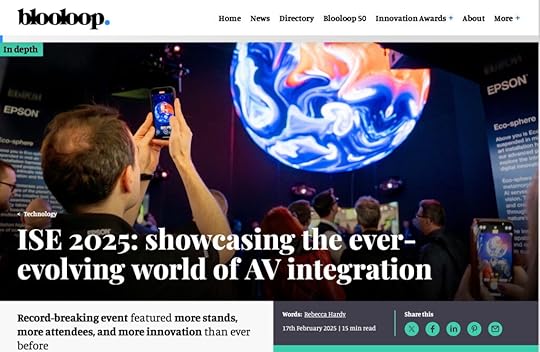
Source: blooloop
Integrated Systems Europe (ISE), the world’s largest AV and systems integration show, took place in Barcelona at the Fira Barcelona, Gran Vía from 4 to 7 February 2025. The event welcomed 85,351 unique visitors from 168 countries and filled the vast conference venue with 1,605 stands, an extended content programme, and new areas for both esports and drones & robotics.
This year’s event highlighted industry megatrends, including AI, audio, cybersecurity, retail, and sustainability. With a 20% larger show floor, advanced technologies were exhibited across all eight of the Fira’s halls. Exhibits celebrated the innovation and creativity of the AV and integration community.
“ISE 2025 has surpassed all expectations, setting new milestones in both attendance and innovation,” said Mike Blackman, managing director of Integrated Systems Events.
Keynotes at ISE 2025AI is Eating the World: Why the AI Revolution is Good for Business
The opening keynote, AI is Eating the World: Why the AI Revolution is Good for Business, was presented by Brian Solis, head of global innovation at cloud-based platform ServiceNow. Solis is a renowned leader in AI integration, digital analyst, and author. He shared his insights on how AI can advance the pro AV and systems integration industry.
“There is no playbook for how to integrate AI in our work,” said Solis. “Which makes it difficult, but also special.”
Arguing for a disruptive approach to AI, Solis shared how the technology can help us to think outside of the box and “unlock the unknown”, going beyond iterative approaches to discover game-changing use cases.
“This is quite literally a ctrl-alt-delete moment,” he said. “That means you have to imagine how to reboot yourself.”
We can shape this, he said, by asking, ‘What would AI do?’ (#WWAID) and using exploratory promoting around the organisation’s key issues to discover new ways of working.
“When AI starts to become magical is where you expect the unexpected,” he said. “Where you do not know what is on the other side of your prompt. And you keep prompting until you come up with something magical.”
Future Panel Discussion – Visions of Tomorrow followed the keynote. In this session, Solis was joined by Quayola, digital artist and creative keynote speaker, Sarah Cox, founder and MD of Neutral Human, and Fardad Zabetian, co-founder & CEO of KUDO, in a discussion hosted by Josephine Watson, managing editor of TechRadar.
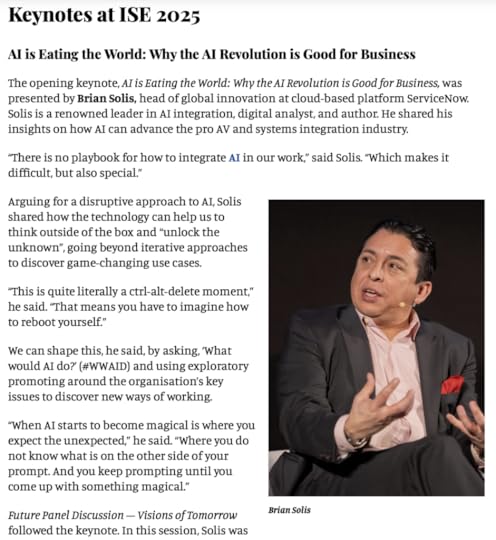
Screenshot
The post blooloop – ISE 2025 Keynote: Brian Solis, AI is Eating the World and Why the AI Revolution is Good for Business appeared first on Brian Solis.
February 17, 2025
Brian Solis Keynote: Reimagining Retail in an AI-Forward World
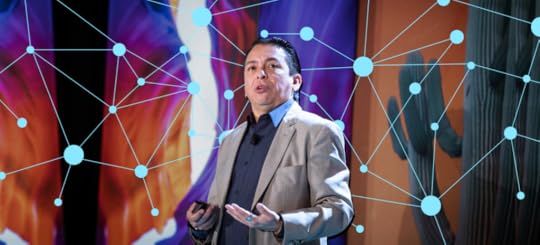
Originally posted at RetailSpaces
At RetailSpaces, futurist and digital anthropologist Brian Solis took the stage to deliver a message that cut through the noise of AI and tech trends. While generative AI is reshaping the retail landscape, Solis reminded the audience of a timeless truth: the heart of innovation is understanding people.
The Consumer at the CenterSolis’s work as a digital anthropologist focuses on how technology transforms behaviors—not just for consumers but also for employees. “We spend so much time designing the bridge but forget about the people crossing it,” he explained. This shift in priorities is crucial for retailers navigating today’s hybrid physical-digital landscape.
Drawing from his research, Solis introduced “Generation Novel” (Gen N), a term he uses to describe a consumer behavior shift that transcends traditional demographics. “It’s not about being Gen Z or Millennial anymore—it’s about how technology and global events like the pandemic have rewired all of us.”
Fidgetal is the FutureThe blending of physical and digital—what Solis humorously called “fidgetal”—is shaping new consumer expectations. Today’s shoppers demand seamless transitions between their online and in-store experiences. Solis highlighted innovations like real-time AI-powered recommendations, modular store layouts, and augmented reality tools that bring products to life, all designed to keep consumers engaged.
“Whether they’re in a store or scrolling on their phones, today’s consumers don’t see a divide between the physical and digital world,” he said. For retailers, this means designing spaces that cater to both worlds—bridging online convenience with in-person connection.
Impatience is the New CompetitorSolis argued that today’s biggest competitor isn’t another brand—it’s consumer impatience. From Uber to curbside pickup, customers now expect speed and convenience in every interaction. “If it’s not fast or intuitive, they’re gone,” Solis explained. For retailers, this means rethinking everything from parking spaces to checkout processes to meet the growing demand for instant gratification.
The Day One MindsetSolis closed with a challenge to retailers: embrace Jeff Bezos’s “Day One” philosophy. “Every day should feel like the first day of your business,” he said. “The moment you rest on your laurels is the moment you become irrelevant.”
For Solis, innovation isn’t just about adopting the latest tech—it’s about reimagining spaces and strategies to meet the evolving needs of consumers. As he put it, “The future of retail isn’t just digital or physical—it’s human.”
The post Brian Solis Keynote: Reimagining Retail in an AI-Forward World appeared first on Brian Solis.
February 4, 2025
Integrated Systems Europe: Brian Solis’ Opening Keynote to address why AI is good for business
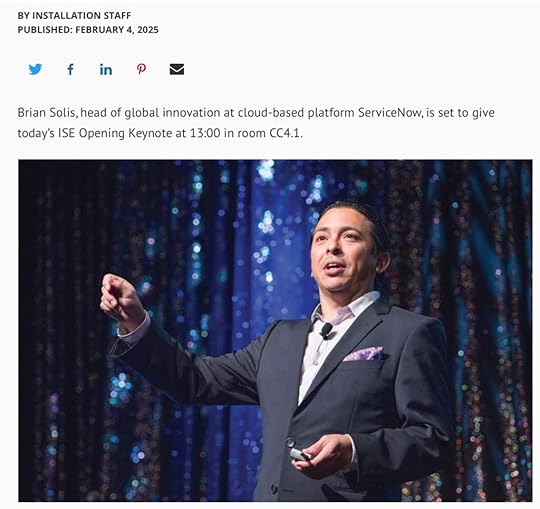
Screenshot
Source: Installation International
Brian Solis, head of global innovation at cloud-based platform ServiceNow, is set to give today’s ISE Opening Keynote at 13:00 in room CC4.1.
An acclaimed digital analyst, author and visionary, Solis was named a ‘Top AI Leader’ for 2024 by Rethink Retail, recognizing him as a pioneer of AI integration. He is also well-known as an author of over 60 industry-leading research publications and eight best-selling books exploring disruptive trends, corporate innovation, business transformation and consumer behaviour.
His body of research has studied (and predicted) digital’s impact on business and society and has helped companies and industries change and innovate with purpose and positive outcomes.
Solis’ ISE 2025 Opening Keynote is set to be an essential destination for attendees eager to discover why now is the time for business leaders to rethink their organisations for an AI-defined future.
In the talk, he will explore the future of tech development driven by AI, the opportunities and challenges for the pro AV and systems integration business, and the role each of us plays in shaping the future.
He will delve into why automation has become the standard rather than the objective, why augmentation is the key to setting businesses apart, and how leaders can cultivate the mindset needed to unlock the potential of becoming an AI-first, exponentially growing organisation.
Industry pain points such as inertia, business contact loss and outdated systems will also be touched upon and solutions that restore connections and drive progress will be offered.
Immediately after his Keynote, Solis will be joined by Fardad Zabetian, CEO and co-founder of KUDO; Sarah Cox, founder and managing director, Neutral Human; and digital artist Quayola to share their bold visions for the world of tomorrow, including how emerging technologies such as AI, AR, VR and more will redefine how we live, work and play.
The Opening Keynote takes place today at 13:00 in room CC4.1. It is free to attend.
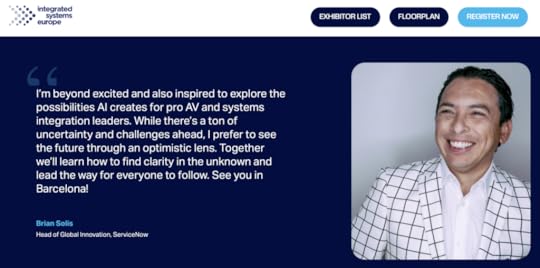
The post Integrated Systems Europe: Brian Solis’ Opening Keynote to address why AI is good for business appeared first on Brian Solis.
February 2, 2025
Brian Solis Set to Keynote the 2025 Future of Marketing Conference Hosted by Georgia State University J. Mack Robinson College of Business
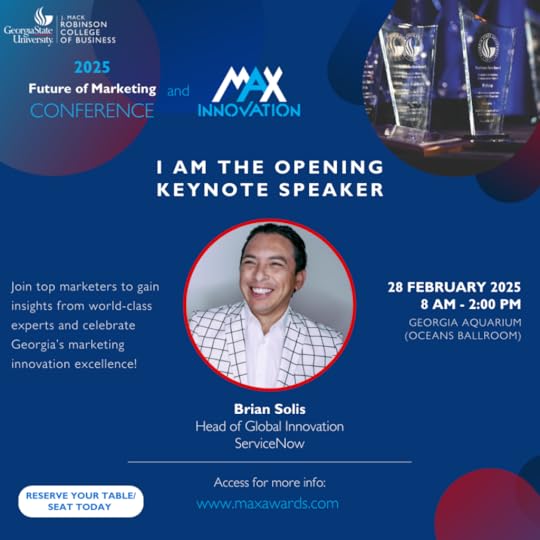
Brian is proud to serve as the opening keynote speaker at the 2025 Georgia State University “Future of Marketing” conference on February 28th, 2025 in Atlanta.
The event will embody hundreds of senior marketers, highlight thought leadership from world-class marketing experts and futurists, and recognize excellence in marketing innovation from organizations based in Georgia.
The post Brian Solis Set to Keynote the 2025 Future of Marketing Conference Hosted by Georgia State University J. Mack Robinson College of Business appeared first on Brian Solis.


